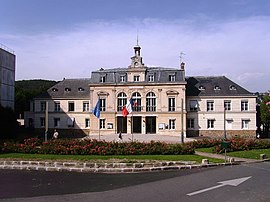Commune in Île-de-France, France
.mw-parser-output .hidden-begin{box-sizing:border-box;width:100%;padding:5px;border:none;font-size:95%}.mw-parser-output .hidden-title{font-weight:bold;line-height:1.6;text-align:left}.mw-parser-output .hidden-content{text-align:left}@media all and (max-width:500px){.mw-parser-output .hidden-begin{width:auto!important;clear:none!important;float:none!important))You can help expand this article with text translated from
the corresponding article in French. (July 2014) Click [show] for important translation instructions.
View a machine-translated version of the French article.
Machine translation, like
DeepL or
Google Translate, is a useful starting point for translations, but translators must revise errors as necessary and confirm that the translation is accurate, rather than simply copy-pasting machine-translated text into the English Wikipedia.
Do not translate text that appears unreliable or low-quality. If possible, verify the text with references provided in the foreign-language article.
You must provide
copyright attribution in the
edit summary accompanying your translation by providing an
interlanguage link to the source of your translation. A model attribution edit summary is Content in this edit is translated from the existing French Wikipedia article at [[:fr:Orsay]]; see its history for attribution.
You may also add the template ((Translated|fr|Orsay)) to the
talk page.
For more guidance, see
Wikipedia:Translation.
Commune in Île-de-France, France
Orsay (pronounced [ɔʁ.sɛ]) is a commune in the Essonne department in Île-de-France in northern France. It is located in the southwestern suburbs of Paris, France, 20.7 km (12.9 mi) from the centre of Paris.
A fortified location of the Chevreuse valley since the 8th century and agricultural domain of wealthy and influential people, the development of Orsay is marked by the introduction of a railroad in the second half of the 18th century (today the RER B of which two stations are located in Orsay) and donations which allow the construction of a hospital still active to this day. Seat of the Orsay campus of Paris-Saclay university, crossed by the 118 national road, Orsay has become a residential city of the Paris metropolitan area and the Chevreuse valley, easily accessible and with a preserved environment at the heart of the Paris-Saclay scientific cluster with laboratories of the CNRS and the Curie institute on its territory.
Inhabitants of Orsay are known as Orcéens.
History
There has been a village called Orsay on this site since 999, and the first church there was built in 1157. From the sixteenth century, the town and surrounding area were owned by the Boucher family, and it was in honour of this family that Louis XIV gave the quai d'Orsay its name. This is the reason that the Musée d'Orsay is not in Orsay. In the eighteenth century, the family of Grimod du Fort bought the land and received the title of comte d'Orsay.
In 1870, during the Franco-Prussian war, Orsay was occupied by the Prussian army.
88 young "Orcéens" were killed in the First World War.
In 1957, largely due to the influence of Frédéric and Irène Joliot-Curie, the Institut de physique nucléaire (nuclear physics institute) was opened in the Chevreuse valley, and the region, especially Orsay, became an important scientific centre. Another development was the creation of the Université de Paris-Sud, whose most important faculty is the faculty of science.
On 19 February 1977, a part of the territory of Orsay was detached and merged with a part of the territory of Bures-sur-Yvette to create the commune of Les Ulis.
Transport
Orsay is served by two stations on Paris RER line B: Le Guichet and Orsay-Ville.
Places of worship
The territory of the city is divided in two catholic parishes which depend on the diocese of Évry–Corbeil-Essonnes and the deanery of Yvette-Gif-Orsay. The parish of Ulis-Montdétour-Montjay serves the neighborhood of Montdétour, bois du Roi and bois Persan, while the parish of Orsay serves the rest of the city. These parishes have the main church of Saint-Martin-Saint-Laurent, the chapel of la Clarté-Dieu and the chapel of Notre-Dame-de-la-Plaine at Mondétour.
Additionally, the city has a Portuguese evangelical parish and an international evangelical church: the église évangélique vie et paix.
A Bhuddist Khuông Viêt pagoda is also located in the city.





